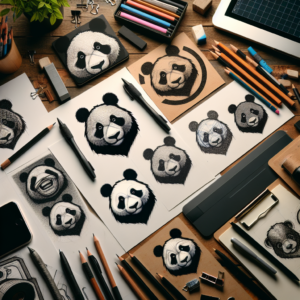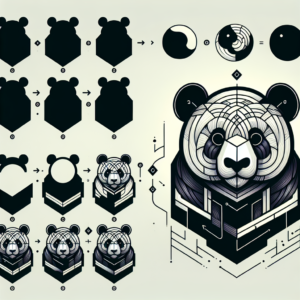Create an Exquisite WWF Panda Logo With Illustrations and Vector Graphics for Wildlife Enthusiasts
Welcome to our blog, where we embark on an exciting journey into the captivating world of wildlife conservation and the artistry behind the iconic WWF Panda logo. If you’re a wildlife enthusiast with a love for exquisite illustrations and vector graphics, you’re in for a treat! Join us as we delve into the mesmerizing process of crafting this remarkable logo that has captured the hearts of millions around the globe. From the stroke of a brush to the meticulous attention to detail, we’ll uncover the secrets behind the creation of this symbol of hope and preservation. Let’s embark on this delightful adventure together, where creativity meets a passion for protecting our precious wildlife.
Introduction
As we dive into the captivating world of wildlife conservation and art, we embark on a journey that merges creativity and purpose. In this blog, we will explore the artful process of crafting an exquisite WWF Panda Logo using illustrations and vector graphics. Personally, I have always been deeply connected to both wildlife conservation and art. The ability to create something visually captivating while raising awareness for the protection of our planet’s biodiversity is a true passion of mine.
The Symbolism of the WWF Panda Logo

The WWF Panda Logo holds immense significance in the realm of wildlife conservation. It has become an iconic symbol representing the protection and preservation of endangered species.
The inspiration for the logo came from Chi-Chi, a giant panda living at the London Zoo in 1961, the same year WWF was created.
As one of the strongest symbols in conservation, Sir Peter Scott drew the first logo in 1978, aiming to create a brand identity that would overcome all language barriers. The genius behind this excellent logo was environmentalist and artist Gerald Watterson, who tailored the design to describe the gentle yet impactful nature of these magnificent creatures.
The panda quickly became more than just a symbol for WWF; it became an icon for the entire conservation movement. The choice of a panda as the organization’s mascot was deliberate. Pandas are well-known and beloved animals that symbolize the importance of wildlife conservation. They are also a species that has faced the threat of extinction, making them a powerful representation of the need to protect biodiversity.
The black-and-white panda logo has come to stand as a universal symbol for the conservation movement as a whole. It signifies the efforts of organizations like WWF to protect endangered animals, their natural habitats, and the overall well-being of our planet’s ecosystems. With its black-patched eyes and bold impact in black and white, this logo has become a marketing solution for many agencies.
Sources- World Wildlife Fund, WWF Panda, Pop Icon Life
How to create a WWF-Inspired Panda Logo?
Conceptualization and Sketching
The WWF Panda logo design is an iconic symbol that represents the World Wildlife Fund and its dedication to wildlife conservation. To create a WWF-inspired Panda logo, it is important to understand the significance of brainstorming and sketching in the logo creation process.

Importance of brainstorming and sketching in logo creation
Brainstorming and sketching are crucial steps that allow designers to explore different logo ideas, concepts, and visual representations.
By researching and gathering inspiration from wildlife photography, nature documentaries, and conservation organizations, designers can gain a deeper understanding of the characteristics, behavior, and symbolism associated with animals and wildlife. This research helps in creating a logo that effectively communicates the message of conservation and resonates with wildlife enthusiasts.
Factors to consider when designing a Panda logo for wildlife enthusiasts
When designing a logo for wildlife enthusiasts, several factors should be considered:
- Symbolism: Choose an element or animal that had an impact on wildlife conservation and resonates with the target audience. Consider the unique qualities and symbolism associated with different animals and how they align with the values of conservation and appreciation for wildlife.
- Simplicity: A logo for wildlife enthusiasts should be simple and easily recognizable. A clean and minimalistic design ensures that the logo is memorable and versatile, allowing it to be used across various platforms and sizes.
- Color Palette: Select colors that evoke a sense of nature and wildlife. Earthy tones and environmental hues are often used to convey a connection to nature. Consider the psychological impact of colors and their associations with specific animals or habitats.
- Typography: Choose a font that complements the overall style and theme of the logo. It should be legible and reflect the desired tone, whether it’s bold and impactful or elegant and subtle.
- Balance and Composition: Pay attention to the arrangement and balance of elements within the logo. Ensure that the design is visually pleasing and harmonious, with a clear focal point that draws the viewer’s attention.
Vector Graphic Creation

In the process of creating a vector graphic for the WWF Panda logo, it is essential to follow a step-by-step process:
- Begin by sketching rough drafts of the panda logo, and exploring different poses, expressions, and compositions.
- Refine the sketches, focusing on the panda’s distinctive features such as its black-and-white furry, adorable round face, and friendly demeanor.
- Use graphic software to create the final design. Start by creating basic shapes and lines to form the outline of the panda.
- Add details such as the panda’s eyes, nose, ears, and limbs, paying attention to proportion and symmetry.
- Experiment with different variations of the logo, exploring different poses or incorporating additional elements like bamboo leaves or the WWF initials.
- Select an appropriate color palette for the logo, using shades of black and white for the panda and considering nature-inspired colors for any additional elements.
- Ensure that the logo is scalable without losing quality or clarity, allowing it to be used across various mediums and sizes.
Finalizing and Refining the Design
In the final stages of refining the design, feedback, and iteration play a crucial role. Seek feedback from colleagues, clients, or target audience members to gain different perspectives and insights. Use this feedback to make necessary adjustments and improvements to the logo. Refine the typography, color choices, and overall composition to create a visually appealing and polished design.
Impactful Conservation Stories
The WWF Panda Logo stands as more than just a symbol; it embodies a commitment to conservation that has left an indelible mark on wildlife protection efforts worldwide. Through impactful case studies and compelling examples, the profound influence of the WWF Panda Logo in the realm of wildlife conservation becomes evident.
In one notable case, the logo served as a rallying point for a successful campaign to protect a critically endangered species. Its recognizable image became synonymous with the urgency of the cause, mobilizing communities and garnering widespread support. The logo’s ability to transcend language barriers played a crucial role in fostering global awareness and empathy for endangered wildlife.
Furthermore, the WWF Panda Logo has been instrumental in shaping policy changes and corporate responsibility initiatives. Its presence in products and collaborations has sparked conversations about sustainable practices, prompting businesses to adopt eco-friendly policies and contribute to conservation efforts.
These conservation stories highlight the far-reaching impact of a well-designed logo. The WWF Panda Logo not only symbolizes the organization’s mission but also serves as a catalyst for positive change, inspiring collective action to protect our planet’s precious biodiversity. In every success story, the logo stands tall as a testament to the collective power of individuals and organizations united in the pursuit of a sustainable and harmonious coexistence with nature.
Conclusion
Creating a captivating logo like the WWF’s panda is no small feat. But with dedication and the right tools, your wildlife-focused brand can have an iconic symbol all its own. These design tips will equip you to capture the essence of your animal or conservation message. Remember, a powerful logo instantly connects with your audience and resonates with their values.
Ready to Make Your Mark on the Wildlife World?
While these tips provide a solid foundation, crafting a truly professional logo can be a complex process. At Leostar Design, our team of passionate graphic designers specializes in creating logos that not only look amazing but also deliver a clear message. We’ll work closely with you to understand your vision and translate it into a logo that embodies your dedication to wildlife conservation.
Wouldn’t it be incredible to see your logo proudly displayed on wildlife merchandise, websites, or even fundraising materials? With Leostar Design, you can turn that dream into reality. Visit our website to learn more about our professional logo design services and take the first step towards making a lasting impact on the wildlife you care about.






